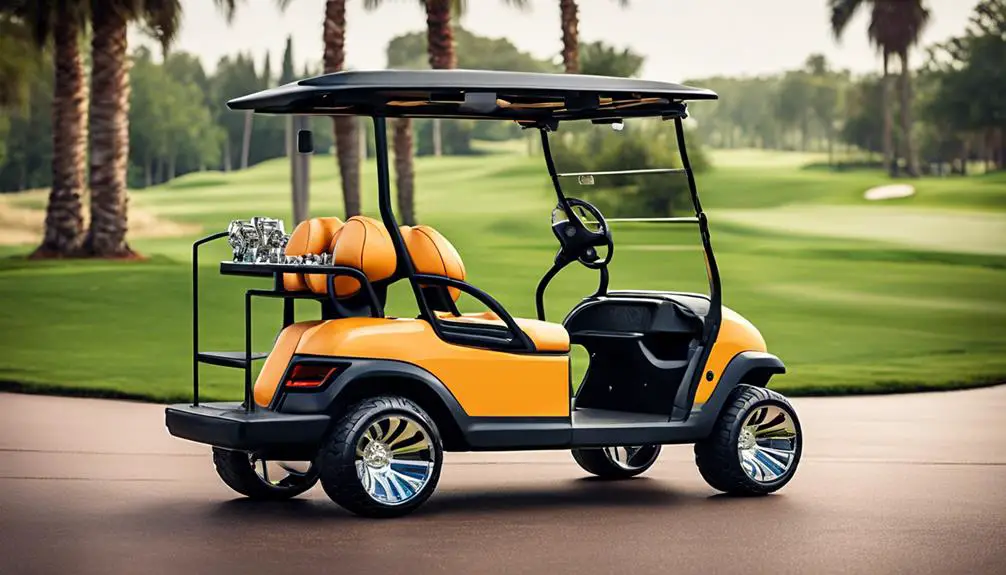What Is An LSV Golf Cart? An LSV is a Low Speed Vehicle. It is defined by law as a 4-wheeled vehicle whose maximum speed falls between 20 and 25 mph on a flat paved road. An LSV Golf Cart is an electric golf cart that has been modified to be street legal by the addition of locally mandated and DOT-approved equipment and meets these Federal laws.
Are you puzzled about the term ‘LSV’? Do you wonder if your reliable golf cart requires an upgrade? This confusion is not uncommon. Within the vast universe of golf carts, comprehending the uniqueness of an LSV can be as challenging as locating your golf ball in the rough after a stray swing. ‘Is this just another intricate acronym in the infinite golf lingo, or does it hold some significance for me and my cart?’ I perceive your query.
It’s absolutely normal to question the worth of upgrading to an LSV (Low-Speed Vehicle), considering its potential impact on your finances. After all, if your current cart efficiently transports you from the clubhouse to the 18th hole, why tamper with its functionality? But here’s the fact: knowledge equips you with power, particularly when it involves enhancing your golfing experience and potentially upgrading your vehicle.
So, let’s embark on a no-nonsense, straightforward exploration into the realm of LSVs. I guarantee to maintain authenticity, illuminating what an LSV is, why it might be the unanticipated upgrade your golfing routine requires, and how it can provide more than just a commute across the golf course. Are you prepared to uncover the truth about LSVs? Let’s commence our journey.
Key Takeaways – What Is An LSV?
Transforming your golf cart into an LSV (Low-Speed Vehicle) is not just about upgrading; it’s a lifestyle shift. This change brings with it freedom to roam beyond the golf course, versatility in usage, and compliance with both environmental and legal standards. Think of it as your golf cart on steroids, but the legal, green kind. Here’s the gist:
- Understanding LSV: An LSV is more than a pimped-out golf cart. It meets specific federal and state regulations to legally hit the roads.
- Environmental and Economic Benefits: Going electric with an LSV not only reduces your carbon footprint but can also be kinder to your wallet in the long run.
- It’s a Green Light: Converting your golf cart to an LSV isn’t a back-breaking bank buster. With the right guidance, it’s an achievable dream.
Conventional Approaches to Golf Cart Enhancement
Upgrading a golf cart usually starts with aesthetics and power. Brighter colors, more horsepower, perhaps even a sound system for those leisurely cruises. These enhancements might make for a great show within the confines of a golf community, but they fall short on open roads, both in legality and practicality.
The transformation into an LSV is not about mere looks or speed; it’s about elevating your golf cart to meet street-legal standards. Why limit your mobility to the edges of the golf course when the whole town can be your playground?
You may wonder:
- “Isn’t converting a golf cart into an LSV a complex and costly affair?”
It’s a common concern. Yes, transforming your cart into a street-legal LSV requires adding essential safety features like:
- Headlights
- Taillights
- Turn signals
- Brake lights
- Windshield
- Horn (in some municipalities)
- Seat belts (including the passenger side) for each designated seat
- Exterior mirrors
- Valid Driver license
- License plate
- Vehicle Identification Number (VIN)
- Vehicle registration
- Insurance
And ensuring it can cruise at a safe speed of 20-25 mph. However, the benefits far outweigh the effort. Imagine a vehicle that’s not only eye-catching but also fully equipped to take you from a casual round of golf to running errands around town.
This shift is about more than just upgrading; it’s about repurposing your golf cart for greater utility and sustainability. It’s a move towards a more sustainable lifestyle, aligning with the increasing global emphasis on eco-friendly transportation.
While the traditional route of upgrading your golf cart might seem enticing for its quick fixes and flair, it misses the mark on enhancing your vehicle’s real-world utility and legality. Transitioning to an LSV opens up new avenues of freedom and functionality, marrying the thrill of customization with the satisfaction of making environmentally sound choices. It’s not just an upgrade; it’s a transformation towards a smarter, greener way of living.
The LSV Transformation: A Superior Method
Now, let’s address a few elephants in the room, shall we? There’s a notion that this whole LSV business sounds like:
- A lot of paperwork
- Inspections
- And, let’s not forget, the dreaded expense.
“Is all this hassle really worth it?” you might wonder as you eye your trusty golf cart, contemplating its fate.
First off, the paperwork and regulatory hoops are not as daunting as they appear. Many states have streamlined processes for LSV registration, recognizing the growing popularity of these eco-friendly rides.
And yes, there will be initial costs involved in making your golf cart street-legal. But let’s put this into perspective. Investing in an LSV conversion is not just spending money; it’s investing in:
- Freedom
- Eco-friendliness
- Community spirit
It’s about paving the way for a future where short trips don’t automatically mean jumping into a gas-guzzling SUV.
Moreover, consider the long-term savings on:
- Fuel
- Maintenance
- And even parking fees
An electric LSV is not only cheaper to run than a traditional car; it’s also gentler on the environment and can maneuver through tight spaces where larger vehicles wouldn’t dare venture.
Plus, there’s the undeniable cool factor of zipping around town in a vehicle that’s truly yours, tailored to your preferences and lifestyle needs.
But what about those who argue, “My golf cart is fine just the way it is. Why fix what isn’t broken?” To them, I say, think of it not as fixing but as evolving. Your golf cart can be so much more than a vehicle that shuttles you from one hole to the next.
With a few modifications, it transforms into an LSV, a testament to your commitment to:
- Sustainability
- Efficiency
- Innovation
It becomes a symbol of what’s possible when we think outside the box—or in this case, the golf course.
In the end, the journey from golf cart to LSV is about embracing change and the numerous benefits it brings. It’s a chance to redefine what personal transportation means, blending the lines between recreation and practicality, all while doing our part for the planet.
So, as you consider this transformation, remember: it’s not just about getting from point A to point B. It’s about how you get there, the impact you make, and the statement you’re making about the kind of future you want to drive towards.
Addressing Counterarguments
Cost Concerns often top the list of hesitations when considering the transition from a regular golf cart to an LSV. The initial outlay for upgrades and legal compliance can indeed present a sticker shock.
But let’s break it down, shall we?
Investing in an LSV conversion is akin to opting for an electric car over a gas-guzzler. There’s an upfront cost, yes, but the savings in:
- Fuel
- Maintenance
- Environmental impact fees
add up, making it a savvy long-term choice.
Practicality might be another stumbling block in your mind.
“Where would I even drive an LSV?” you might wonder.
Consider this: local errands, visiting friends within your community, or a quiet drive on local roads—all without the carbon footprint of a traditional car. An LSV isn’t just a golf cart; it’s a statement of sustainable mobility.
Then there’s the Environmental Impact—a counterargument that’s actually a pro in disguise.
The shift towards electric LSVs is a step towards reducing our reliance on fossil fuels and minimizing our ecological footprint. It’s an investment not just in personal convenience, but in the planet’s future.
Embracing the LSV Lifestyle
Converting your golf cart into an LSV is more than an upgrade—it’s a lifestyle change.
It’s about recognizing the potential in what might seem ordinary and transforming it into something extraordinary. An LSV allows you to blend the love for the open green with the roads that lead there, all while being mindful of the environmental and social impact of our transportation choices.
The journey from a standard golf cart to a fully functional LSV is filled with learning, adaptation, and a bit of pioneering spirit. But the destination? A world where mobility is cleaner, greener, and more connected.
So, why wait? The road less traveled is calling, and it’s perfectly legal for your new LSV.
Can My Golf Cart Be An LSV and Street Legal?
In short, almost any golf cart can be brought up to specs with the addition of the safety equipment. The hard part is increasing the speed to reach the minimum required by local law. Remember that an LSV is required to be an electric vehicle, not a gas model, so if your cart cannot exceed 19 MPH on a flat paved county road you will need to modify the motor and/or controller.
| State | Roads Permitted? | Top Speed Permitted for LSV in MPH? |
|---|---|---|
| Alabama | Local option, municipal streets in class 2 municipalities during daylight hours | 25 |
| Alaska | The local ordinance may allow use on roads with a posted speed limit of 45 mph or less; otherwise roads with a posted limit of 35 mph or less. | 25 |
| Arizona | Roads with a posted speed limit of 35 mph or less | 25 |
| Arkansas | Roads on which a low-speed vehicle would not impede the normal and reasonable movement of traffic | 25 |
| California | Roads with a posted speed limit of 35 mph or less | 25 |
| Colorado | Roads with a posted speed limit of 35 mph or less; Colorado DOT may permit LSVs on some roadways with a speed limit equal to 40 mph | 25 |
| Connecticut | No state law | No state law |
| Delaware | Roads, other than dual highways in unincorporated areas, where the posted speed limit is 35 mph or less | 25 |
| District of Columbia | Roads on which a low-speed vehicle would not impede the normal and reasonable movement of traffic | 25 |
| Florida | Roads with a posted speed limit of 35 mph or less | 25 |
| Georgia | Roads with a posted speed limit of 35 mph or less | 25 |
| Hawaii | Roads with a posted speed limit of 35 mph or less | 25 |
| Idaho | Roads with a posted speed limit of 35 mph or less | 25 |
| Illinois | Roads with a posted speed limit of 30 mph or less; local ordinance may allow use on roads with a posted speed limit of thirty-five mph or less | 25 |
| Indiana | Roads with a posted speed limit of 35 mph or less | 35 |
| Iowa | Roads with a posted speed limit of 35 mph or less | 25 |
| Kansas | Roads with a posted speed limit of 30 mph or less | 25 |
| Louisiana | Roads with a posted speed limit of 35 mph or less | 25 |
| Maine | Roads with a posted speed limit of 35 mph or less | 35 |
| Maryland | Roads with a posted speed limit of 30 mph or less | 25 |
| Massachusetts | Roads with a posted speed limit of 30 mph or less | 25 |
| Michigan | Roads with a posted speed limit of 35 mph or less | 25 |
| Minnesota | Roads with a posted speed limit of 35 mph or less | 25 |
| Mississippi | No state Law | No state law |
| Missouri | Roads with a posted speed limit of 35 mph or less | 25 |
| Montana | No state law | No state law |
| Nebraska | Roads with a posted speed limit of 35 mph or less | 25 |
| Nevada | Roads with a posted speed limit of 35 mph or less | 25 |
| New Hampshire | Roads with a posted speed limit of 35 mph or less | 25 |
| New Jersey | Roads with a posted speed limit of 25 mph or less; the commissioner may permit use on specified roads where the posted speed limit is greater than 25 mph but not greater than 35 mph | 25 |
| New Mexico | Roads with a posted speed limit of 35 mph or less | 25 |
| New York | Roads with a posted speed limit of 35 mph or less | 25 |
| North Carolina | Roads with a posted speed limit of 35 mph or less | 25 |
| North Dakota | Roads with a posted speed limit of 35 mph or less | 25 |
| Ohio | Roads with a posted speed limit of 35 mph or less | 25 |
| Oklahoma | Roads with a posted speed limit of 35 mph or less | 25 |
| Oregon | Roads with a posted speed limit of 35 mph or less | 25 |
| Pennsylvania | Roads with a posted speed limit of 25 mph or less; the secretary may permit use on specified roads where the posted speed limit is greater than 25 mph but not greater than 35 mph | 25 |
| Rhode Island | Roads on Prudence Island with a posted speed limit of 25 mph or less during the hours of 6:00 am through 6:00 pm | 25 |
| South Carolina | Roads with a posted speed limit of 35 mph or less | 25 |
| South Dakota | Roads with a posted speed limit of 35 mph or less | 25 |
| Tennessee | Roads with a posted speed limit of 35 mph or less | 25 |
| Texas | Roads with a posted speed limit of 45 mph or less | 35 |
| Utah | Roads with a posted speed limit of 35 mph or less | 25 |
| Vermont | Roads with a posted speed limit of 35 mph or less | 25 |
| Virginia | Roads with a posted speed limit of 35 mph or less | 25 |
| Washington | Roads with a posted speed limit of 35 mph or less | 25 |
| West Virginia | Roads within the corporate limits of a municipality where the speed limit is 25 mph or less | 25 |
| Wisconsin | Local option may allow use on roads with a posted speed limit of 35 mph or less | 25 |
| Wyoming | Non-interstate highways on which the vehicle is capable of achieving the maximum speed limit | Not Specified |
Final Thoughts
It would be much better on the pocketbook and environment if we could just share the short travel trips between Large automobiles and LSV’s. It’s easy to add the necessary components and pay the registration fees to make your golf cart a short trip utility vehicle.






